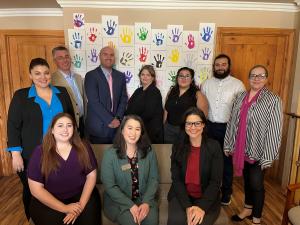A World of Difference
Boyd Law’s Immigration Clinic moves into new downtown location

By Stacy Willis
It’s a simple building: two floors, gray, a single main door with the address marked clearly above it.
The William S. Boyd School of Law’s Immigration Clinic’s new downtown Las Vegas Community Advocacy Office occupies the second floor of 1212 Casino Center Blvd. in the Arts District.
It’s nothing fancy, but its presence here—in contrast to the original Immigration Clinic tucked in the law school’s Thomas & Mack Clinic in the middle of UNLV’s main campus—makes it easier for some new clients to find help, managing attorney Alissa Cooley says.
“We used to have to send the receptionist in a golf cart around campus to find people who were dropped off by an Uber somewhere over by the Thomas & Mack Center,” Cooley says.
The ease of finding the downtown office, which opened in March with a ceremony attended by Governor Steve Sisolak, has shaved about an hour off of intake appointment sessions, she said.
The location has changed, but the important mission remains the same. Cooley and six other employees (and at least one Boyd School of Law student) typically manage about 200 pro bono cases at any given time. They defend unaccompanied children (typically those who entered the U.S. by themselves and now live with a relative in Las Vegas) in their removal proceedings and adults who face deportation while detained by U.S. Immigration and Customs Enforcement (ICE).
Operations are funded by $500,000 from the state and $500,000 from Clark County over a two-year-period. Defense attorney and law school adjunct professor Ozzie Fumo donated the space in the building.
Over time, Cooley says, she has grown to develop friendships with some clients.
She once ran into a former client from the Immigration Clinic at a store, five years after she had helped the individual gain residency as a juvenile. She was thrilled to hear that the client was now speaking fluent English and doing well. Another time, she received a photo of siblings graduating high school after she had helped them gain residency as juveniles.
“I watch some of them grow up,” says Cooley, who first worked for the clinic in 2014. Sometimes, she says, the staff members “become like life coaches” as clients try to navigate other facets of their new lives. “We help refer them to other resources, like tax attorneys or social services,” she says.
The original clinic was known for decorating its walls with the painted handprints of clients who gained permanent status. It’s still a tradition in the downtown office’s lobby and conference room.
“Our new clients see them and ask what they are, and they get very excited,” Cooley says. “I shared good news about a work permit with a client last week, and she asked if it was time for her to do her handprint yet.”
But it’s not until a client gains residency, or some other permanent status, that they can get their handprint on the wall.
“We call it a ceremony. We bring them in and we surprise them with their status documents … and then ask them if they want to do a handprint—and they always do.”
---
ABOUT THE CLINIC
- The oldest case on which the Immigration Clinic is working was opened in 2013 and is still open.
- Most clients come from Mexico or Central America.
- The youngest client was 18 months old.
HOW TO SEEK HELP
- For unaccompanied children and detained adults, call 702-476-0750.
- For members of the UNLV and CSN communities, make an appointment online
For DACA renewals, make an appointment online.